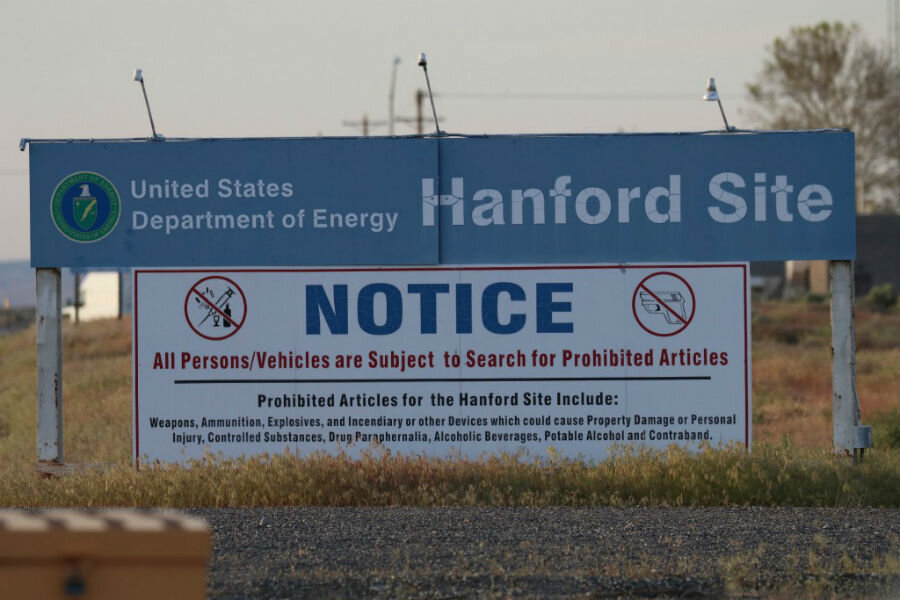Tunnel collapse at Washington State nuclear site raises latest radioactive waste safety concerns
Loading...
| Richland and Spokane Washington
The collapse of an underground tunnel containing radioactive waste that forced workers at the Hanford Nuclear Reservation to shelter in place is the latest incident to raise safety concerns at the sprawling site that made plutonium for nuclear bombs for decades after World War II.
Officials detected no release of radiation Tuesday and no workers were injured, said Randy Bradbury, a spokesman for the Washington state Department of Ecology.
No workers were inside the tunnel when it collapsed, causing soil on the surface above to sink 2 to 4 feet over a 400 square foot area, officials said.
The tunnels are hundreds of feet long, with about 8 feet of soil covering them, the US Department of Energy said.
The anti-nuclear group Beyond Nuclear said the incident helped show “radioactive waste management is out of control.”
Sen. Maria Cantwell (D) of Washington said worker safety must be the priority.
“My thoughts are with the first responders who are working to assess the situation on the ground,” she said.
Worker safety has long been a concern at Hanford, which is located about 200 miles southeast of Seattle.
Washington Attorney General Bob Ferguson filed a lawsuit last fall against the Energy Department and its contractor, Washington River Protection Solutions, contending vapors released from underground nuclear waste tanks posed a serious risk to workers.
Mr. Ferguson said that since the early 1980s, hundreds of workers have been exposed to vapors escaping from the tanks and that those breathing the vapors developed nosebleeds, chest and lung pain, headaches, coughing, sore throats, irritated eyes and difficulty breathing.
Lawyers for the Energy Department have said no evidence has been provided showing workers have been harmed by vapors.
The cause of the collapse was not immediately known. It was discovered Tuesday as part of a routine inspection and occurred during a massive cleanup that has been underway since the 1980s and costs more than $2 billion a year. The work is expected to take until 2060 and cost more than $100 billion.
Hanford officials said they were studying the area of the collapse to determine how to create a barrier between the contaminated equipment in the tunnel and the outside air.
Workers near the site were evacuated and hundreds of others farther away were told to remain indoors for several hours, the federal agency said.
Non-essential workers among the labor force of 9,000 at the site were sent home early along a safe route.
“No action is currently required for residents of Benton and Franklin counties,” the Energy Department said, referring to the nearly 300,000 residents near the site about 200 miles southeast of Seattle. “There is no indication of a release of contamination at this point.”
US Energy Secretary Rick Perry was briefed on the incident that Washington Gov. Jay Inslee called a serious situation.
“Ensuring the safety of the workers and the community is the top priority,” said Mr. Inslee, a Democrat who previously represented the Hanford region in Congress.
The accident occurred at a plant known as the Plutonium Uranium Extraction Facility, or PUREX, located in the middle of the 500-square-mile Hanford site – half the size of Rhode Island.
The PUREX building is the length of three football fields and was used to recover plutonium from irradiated fuel rods.
Hanford for decades made plutonium for nuclear weapons and is now the nation’s largest depository of radioactive defense waste, with about 56 million gallons of waste, most of it in 177 underground tanks.
As part of the huge, ongoing cleanup, rail cars full of radioactive waste were often driven into tunnels and buried.
The senior Democrat on the House Energy and Commerce Committee said he is requesting that the Energy Department brief the committee on the root cause of the collapse.
New Jersey Rep. Frank Pallone said the incident underscores the need for the department to take all necessary precautions to ensure the safety and security of workers.
The committee oversees the department’s management of the cleanup efforts.
The Hanford site was built during World War II and made plutonium for most of the US nuclear arsenal, including the bomb dropped on Nagasaki, Japan, at the end of the war.
Associated Press writer Matthew Daly in Washington, D.C., contributed to this story.







